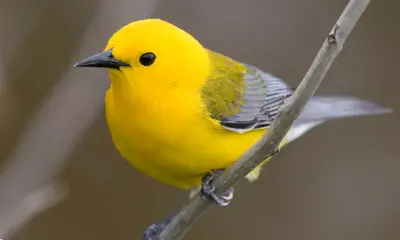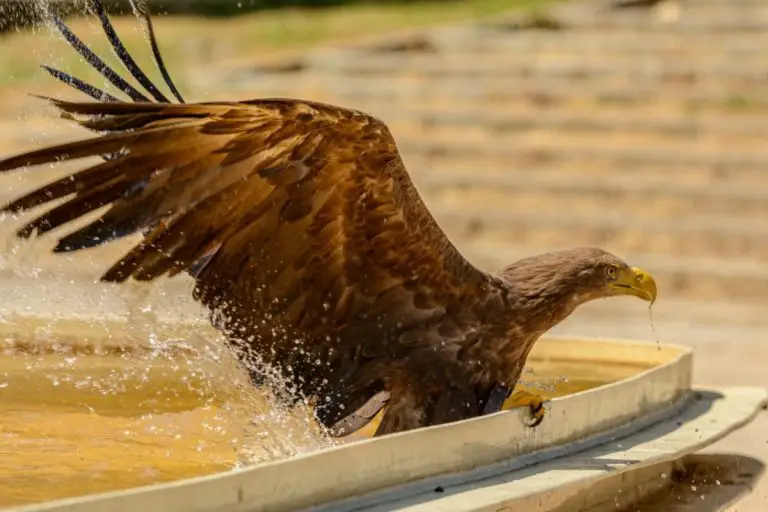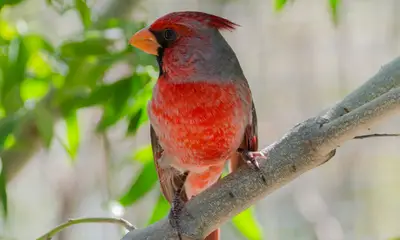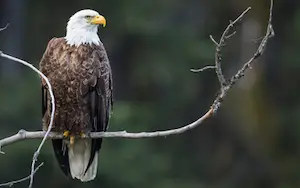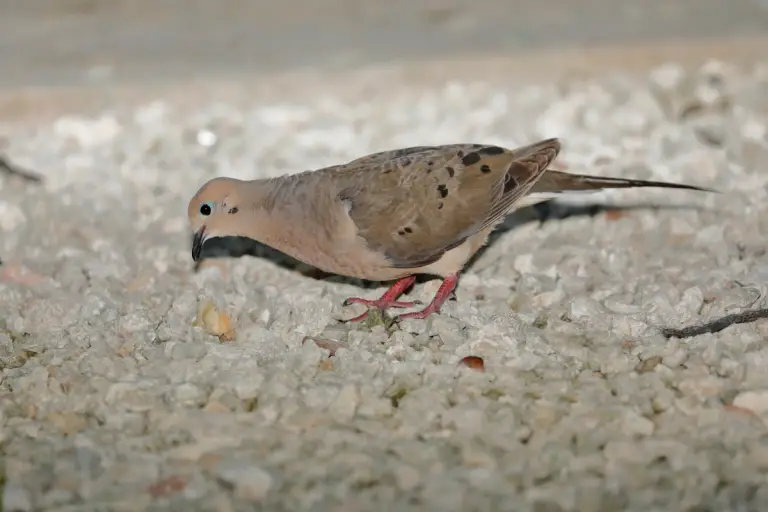Large birds in Wisconsin
17 Types Of LARGE Birds In Wisconsin (ID Guide With Photos)
Did you recently come across a large bird in the state of Wisconsin, and want to know what species it was?
Identifying big birds found in Wisconsin is not as easy as it might seem, since there are many bird species in Wisconsin that are on the large side.
To help you identify the bird you saw, we’ll cover the most common large birds of Wisconsin in this article.
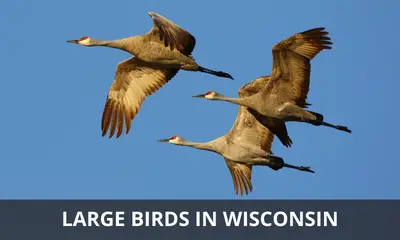
What are the types of large birds in Wisconsin?
The 17 types of large birds that can be seen in Wisconsin are:
- Sandhill Crane
- Great Egret
- Great Blue Heron
- Double-crested Cormorant
- Caspian Tern
- Common Loon
- Osprey
- Bald Eagle
- Golden Eagle
- Turkey Vulture
- Red-tailed Hawk
- Gyrfalcon
- Great Horned Owl
- Snowy Owl
- Canada Goose
- Trumpeter Swan
While many of these big birds are year-round residents of Wisconsin, some only occur in the state during the winter, as migratory birds that spend the cold months in Wisconsin.
Yet other birds are summer visitors during the breeding season, and some are scarce vagrants that are rarely seen in the state (more on that below).
Now let’s dive into the details, and take a closer look at each of these species in order to get the full scoop:
Sandhill Crane
Scientific name: Antigone canadensis
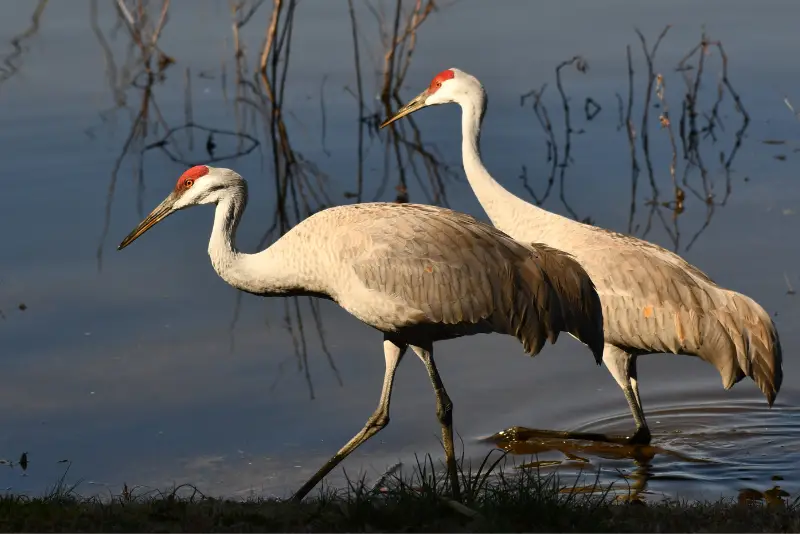
These large birds are up to 4.5 feet tall, which makes them the largest birds in the Badger state.
Adult Sandhill Cranes have pale gray body plumage, as well as a red crown and forehead, which contrasts with a buff white cheek.
Depending on their diet and location, some Sandhill Cranes can have a rusty color instead of the normal gray coloration.
They are well known for their complex courtship dancing rituals and long distance migrations.
These cranes are found in open landscapes with wetlands, prairies, and meadows in Canada and the northern United States. They are rare breeding birds throughout Wisconsin.
Sandhill Cranes form large flocks outside of the breeding season, and migrate to southern parts of the USA and Mexico to spend the winter.
Great Egret
Scientific name: Ardea alba
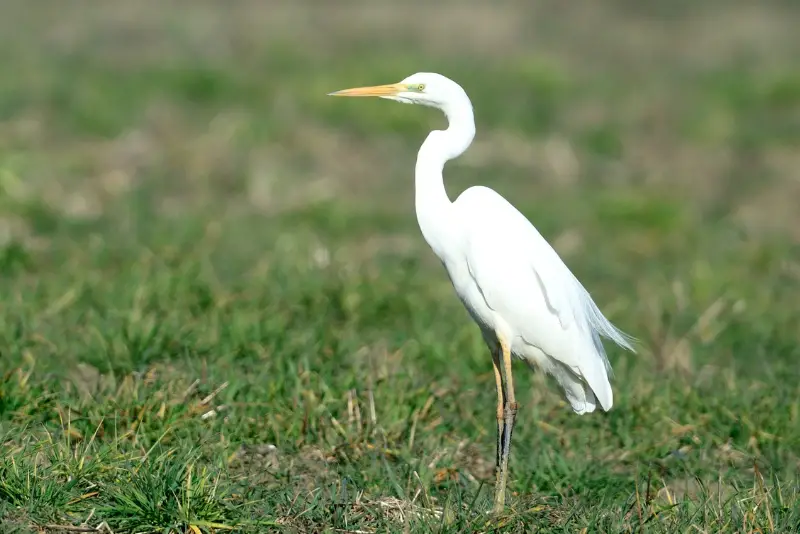
The Great Egret has a range that spans nearly the whole planet, and can be found on almost all continents.
This heron is one of Wisconsin’s largest birds and is a breeding bird in southwestern parts of the state, as well as a statewide visitor during spring and fall migration.
It is all white, and has long black legs and feet along with a thick, yellow bill.
During the summer breeding seasons, the Great Egret grows a plume on its back that extends all the way to the tip of its tail.
It lives in both saltwater and freshwater habitats, and often nests in large colonies on the banks of marshes, lakes, and rivers.
Great Egrets forage in any type of shallow water in Wisconsin, including ponds, lakes, and rivers, as well as flooded areas.
Outside of the breeding season it can be seen in large flocks. This species is one of the white birds that can be seen in Wisconsin.
Great Blue Heron
Scientific name: Ardea herodias
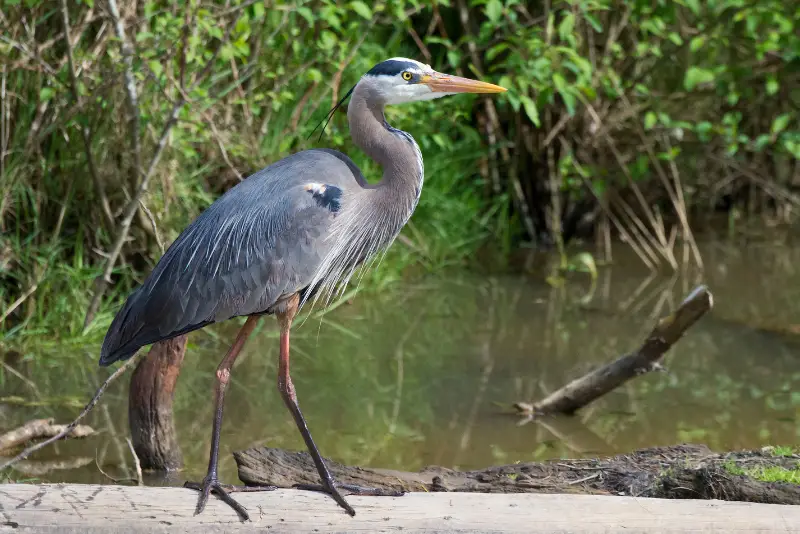
The Great Blue Heron is one of the most common herons in Wisconsin, where it can be seen year round.
With a wingspan of up to 6 feet, this heron is one of Wisconsin’s largest birds. It is almost entirely blue gray, except for a white throat and eye stripe, as well as dark gray wing feathers.
This enormous blue bird in Wisconsin likes to hunt for small fish by wading in the shallows of estuaries, mud flats and marshes along the seaboard.
It waits patiently for a suitably sized fish to come close enough to be grabbed with its long, yellow bill.
Double-crested Cormorant
Scientific name: Phalacrocorax auritus

The Double-crested Cormorant is a large, dark waterbird with a long neck and blue eyes. It is a summer visitor in Wisconsin, and is commonly found on the shores of Lake Michigan.
This cormorant likes to gather in large flocks that roost on trees close to water. It is a skilled diver and hunts fish with its large, hooked bill.
When a group of cormorants flies together, they like to form up in a V shaped formation.
Often these V-shaped formations can be seen in the evening, when the birds fly to their roosting spots in Wisconsin.
Caspian Tern
Scientific name: Hydroprogne caspia
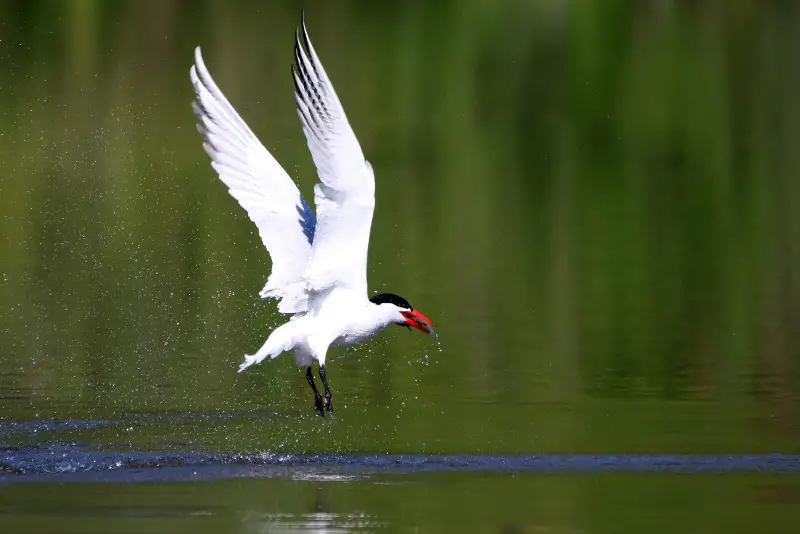
The Caspian tern is the largest tern species in the world, and a rare summer visitor and breeding bird in Wisconsin along the shores of Lake Michigan.
It superficially resembles the Forster’s Tern, but it is a much bigger bird and has a thicker bill, broader wings, and a less forked tail.
Also, during winter the Caspian Tern doesn’t lose its black cap completely, but always retains a streaked, dark crown.
Forster’s Terns, on the other hand, lose their cap entirely during winter, which becomes completely white.
The Caspian Tern is not only a skilled hunter, but this bird also steals food from other terns and gulls. It catches fish by diving into the water with astonishing precision.
The Caspian Tern breeds in freshwater habitats in Canada and northern USA, and winters in the Caribbean and the Gulf of Mexico.
Common Loon
Scientific name: Gavia immer
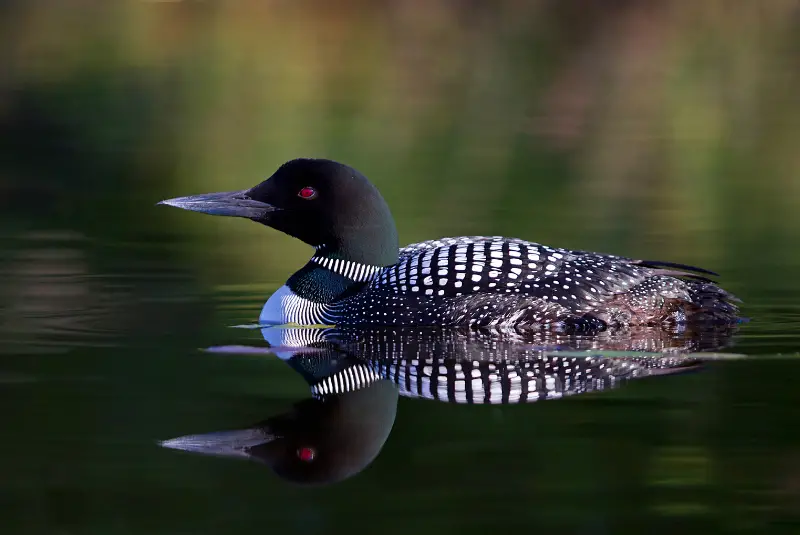
If you spotted a black waterbird with white dots, it is most likely the Common Loon (also known as the Great Northern Diver).
These water birds breed in northern areas of North America and can be seen in northern Wisconsin during the summer.
They have big rounded heads with sharp beaks that resemble a dagger.
In the summer months, the birds have black heads, white chests, and lots of white spots on their black-colored plumage. In the winter or autumn months, their color dulls and turns into a pale gray.
The common loon is a fantastic diver and is super stealthy when it hunts underwater, allowing it to sneak up on fish without even a splash. It can dive to depths of up to two-hundred fifty feet.
To top that off, these birds can stay submerged for up to five minutes and even swallow their prey while they are still underwater.
They have a wingspan of between forty and fifty inches and can live for up to thirty years of age.
Osprey
Scientific name: Pandion haliaetus

The Osprey is one of the largest Wisconsin birds of prey, and with a wingspan of up to 69 in (5.5 ft) it resembles an eagle in size.
It is usually easy to identify the Osprey due white belly and chest, which contrast with its blackish gray upperparts and black wrist patches on its lower wings.
This Wisconsin bird is the only raptor species that plunges into the water in order to catch fish, often becoming entirely submerged in water as it attempts to grab a fish with its feet.
Ospreys are almost always found close to water, except during migration, when they will cross areas without water.
It is a common breeding bird and summer visitor in Wisconsin, where it is most commonly found along the shore of the Badgers.
Bald Eagle
Scientific name: Haliaeetus leucocephalus
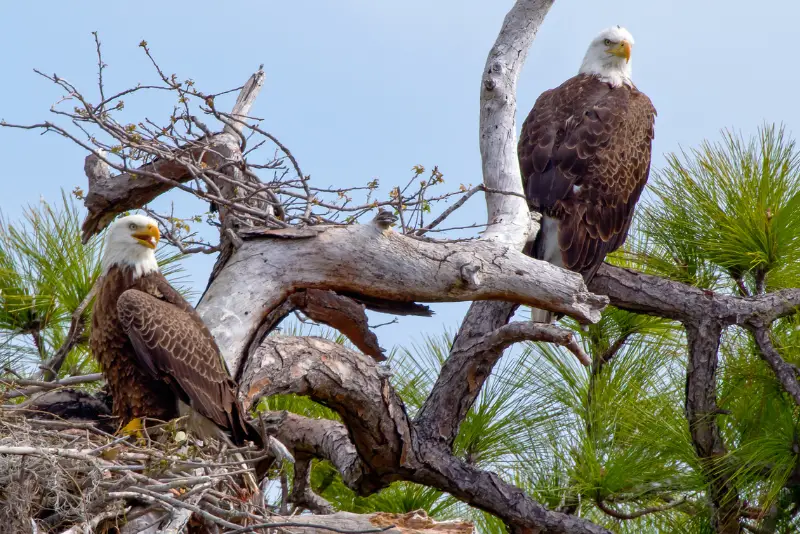
With a wingspan of up to 8 feet, the Bald Eagle is a huge raptor, and impossible to miss if you spot it soaring in the Badger State.
Apart from its size, it is also one of the most easily recognizable birds in Wisconsin, due to its white head and tail, which contrast sharply with the uniformly dark brown body.
Juvenile birds are dark brown all over, with light irregular streaks all over the body, as well as a buff white belly.
This large eagle is a breeding bird in northern Wisconsin, and is also found in other parts of the state outside of the breeding season.
Bald Eagles spend a lot of their time soaring on thermal currents with their wings held flat. They feed on fish, birds, and small mammals, although a big part of their diet consists of carrion.
Golden Eagle
Scientific name: Aquila chrysaetos
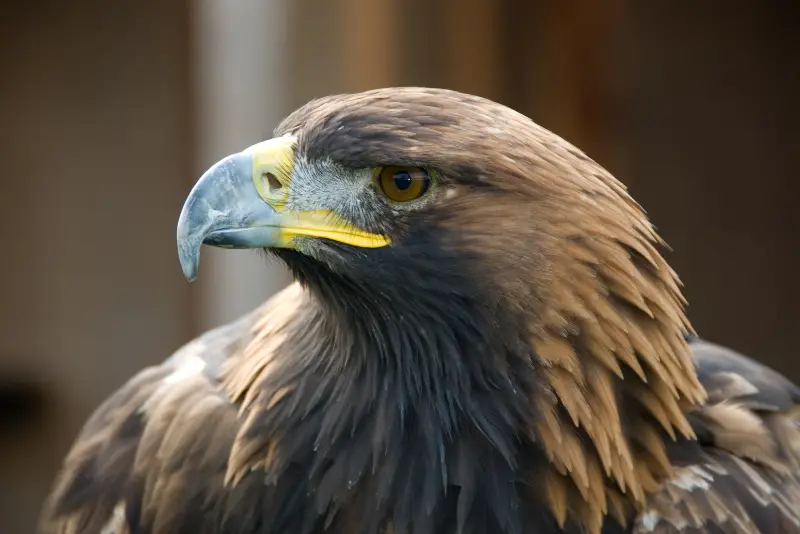
The Golden Eagle is one the most impressive eagle species in North America, and is a breeding bird in the western parts of North America.
In Wisconsin state, the Golden Eagle is an uncommon winter visitor in western parts of the state, and seen sporadically throughout the state during spring or fall migration.
Golden Eagles can be distinguished from Bald Eagles by their lack of white coloration on their heads.
The Golden Eagle is one of few circumpolar raptor species, as it can be found in both the New World and the Old World.
Turkey Vulture
Scientific name: Cathartes aura
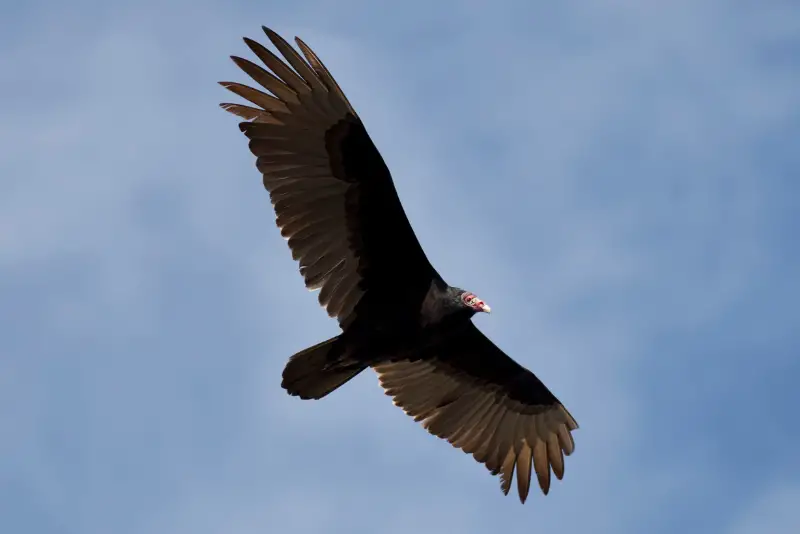
The Turkey Vulture is the largest vulture species breeding in Wisconsin, and can reach a wingspan of up to 6 feet.
It is a big black raptor with a red head, and dark gray rear margins on their wings, which can be seen in flight.
A soaring Turkey Vulture is easily identifiable due to the fact that it holds its wings in an upright V shape.
This big bird is a summer visitor and breeding bird in Wisconsin, where it favors open country interspersed with woodland.
Similar to other vulture species in Wisconsin, this bird is specialized in feeding on carrion, and will often congregate in flocks around roadkill.
While Turkey Vultures look superficially similar to a Black Vultures, the latter are only observed in Wisconsin very rarely.
Red-tailed Hawk
Scientific name: Buteo jamaicensis
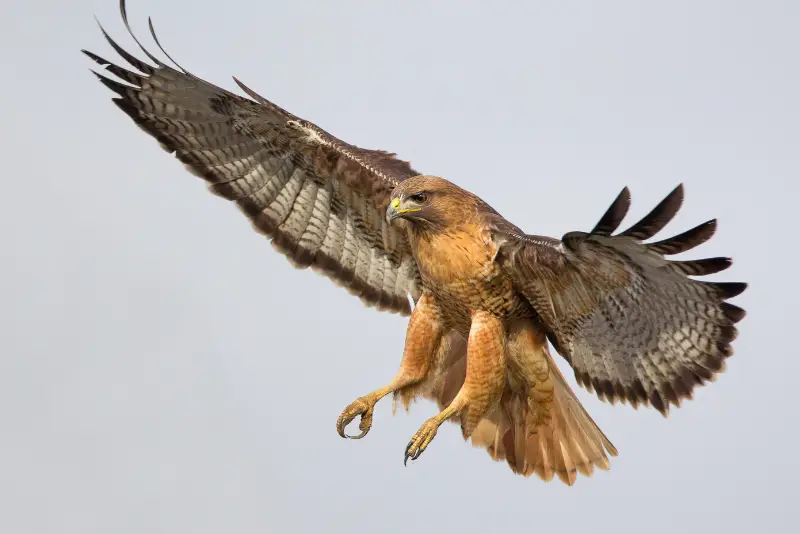
With a wingspan of up to 52 in (4.5 ft), the Red-tailed Hawk is the largest hawk species in Wisconsin.
It has variable coloration, ranging from dark brown to almost entirely white, but can be readily recognized by its rusty red tail.
This large hawk is common in open areas and even in cities. It is most often seen perched on roadside posts or fences, waiting for prey.
The Red-tailed Hawk is one of the most common hawk species in Wisconsin, and can be seen in southern parts of the Badger state year-round, while it is a migratory bird in northern Wisconsin.
It feeds on rodents and other small animals that it catches by swooping down from its perch when they venture out into the open.
Gyrfalcon
Scientific name: Falco rusticolus
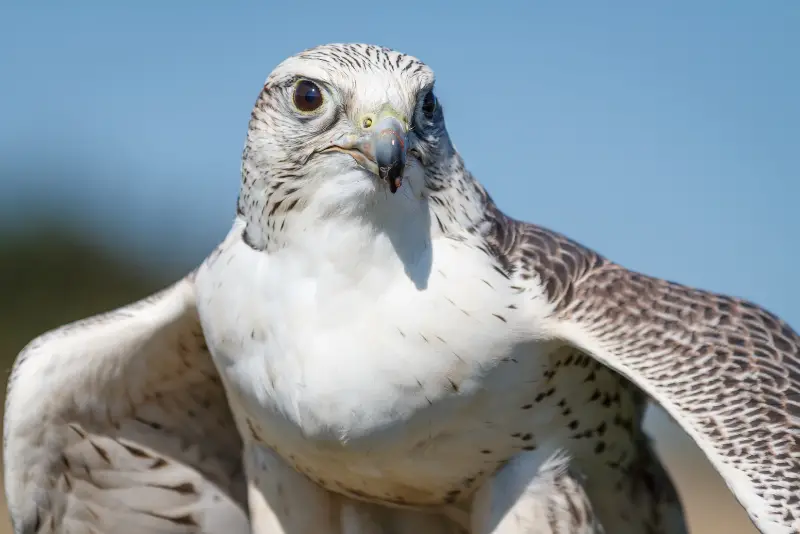
The Gyrfalcon is the largest falcon species in the world, and is significantly larger than a Peregrine Falcon.
It breeds in the high arctic tundra around the entire globe. This falcon is not very common anywhere in the world, but its highest concentrations of breeding pairs are found in Alaska, northern Canada, and Greenland.
They prefer open landscapes, and in their breeding territories, their main prey are ptarmigans, which they catch on or close to the ground.
In their wintering grounds they hunt a wide variety of small and medium-sized birds and mammals.
Gyrfalcons are partially migratory birds, and are rare winter visitors in northern Wisconsin.
Great Horned Owl
Scientific name: Bubo virginianus

With a wingspan up to 4 feet, the Great Horned Owl is the largest owl species breeding in Wisconsin. It is a large rufous brown bird with two tufts (also called horns) and big yellow eyes.
In Wisconsin, this owl starts its nesting very early in the year, laying its eggs in January or February.
It is almost entirely nocturnal, and can hunt in complete darkness by relying on its keen sense of hearing.
The Great Horned Owl doesn’t build its own nest, but instead occupies the nests of other large birds, such as herons or raptors.
It is found year-round throughout Wisconsin, and can be found in a wide variety of habitats in Wisconsin, from woodlands to urban areas.
This owl is a fierce hunter, catching birds up to the size of ducks, and mammals up to the size of squirrels, rabbits, and even young foxes.
Snowy Owl
Scientific name: Bubo scandiacus
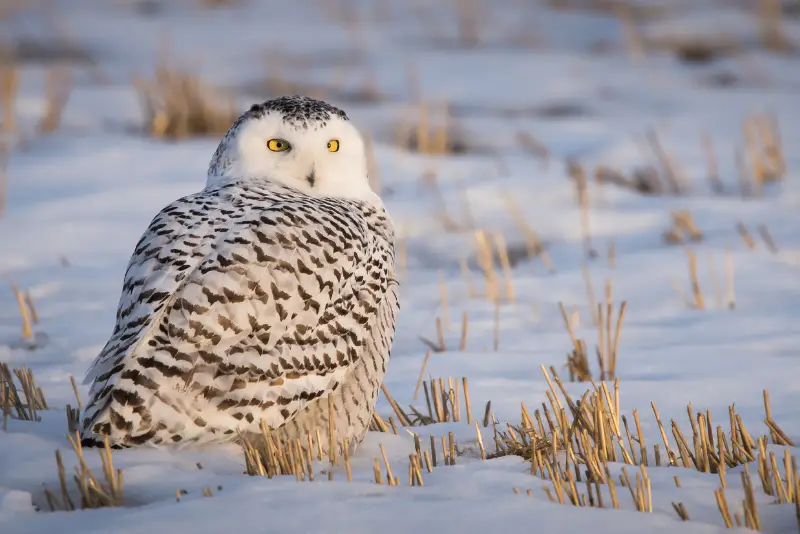
The Snowy Owl is the largest owl species in North America, and weighs more than the Great Horned Owl.
Snowy Owls are rare winter visitors in Wisconsin, where they can be seen in wide open areas, such as shorelines and grassland.
These owls breed in the high arctic well north of the arctic circle, where they hunt ptarmigans and lemmings.
Snowy Owls are easily recognizable by their large size, rounded head white coloration with varying amounts of black markings.
These big birds favor open ground, and can often be observed perching on the ground. In cultivated landscapes they also perch on hay bales, fence posts and telephone poles.
Snowy Owls follow the population changes of small rodents, and are most common in winters with high rodent populations.
Canada Goose
Scientific name: Branta canadensis

The Canada Goose is one of the most easily recognizable aquatic birds, due to its white cheeks that contrast with its jet black neck and head.
They are breeding birds in Canada and northern States, and fly south every fall in large V formations that herald the start of the cold season.
Canada Geese are year-round residents in southern Wisconsin, while they are summer visitors in the northern part of the state.
These Geese like to forage on grain fields after they have been harvested, and are sometimes seen together with Snow Geese.
Trumpeter Swan
Scientific name: Cygnus buccinator
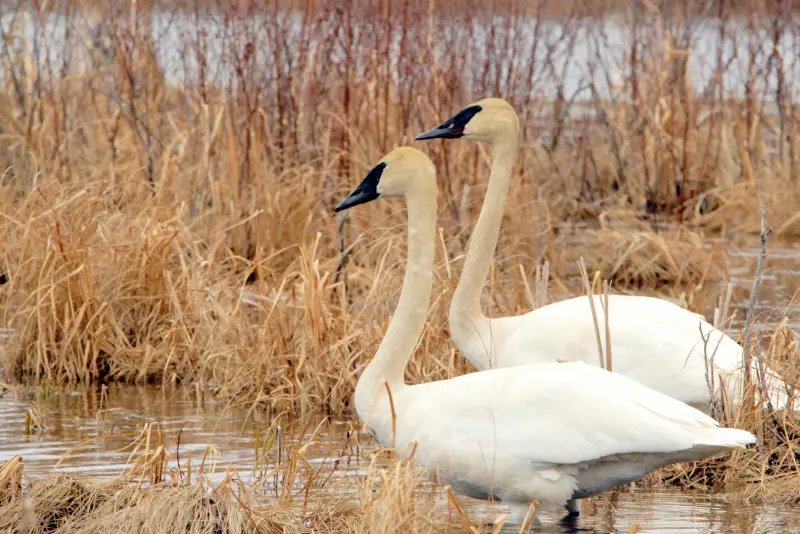
The Trumpeter Swan is a large bird of Canada and the northern United States. It is a very rare breeding bird in the northern parts of Wisconsin, as well as a rare winter visitor in the rest of the state.
These white colored birds are among the largest waterfowl found in North America, and adults are entirely white with a black beak, as well as a black area of skin between the eye and the bill.
In contrast to adults, juveniles are pale gray streaked with white. These swans feed in shallow water, where they use their long neck to reach for aquatic vegetation.
Similar to geese, Trumpeter Swans also feed on leftover grains on harvested farmland.
They spend the winter in areas with lakes or rivers that are free of ice, and they are sometimes forced to fly further south in harsh winters, when all bodies of water freeze over.
What are the big black birds in Wisconsin?
The big black birds found in Wisconsin are Turkey Vultures, which have a wingspan up to 6 feet.
These black-colored vultures are commonly seen in Wisconsin soaring on thermal currents, or gathering in small groups at roadkill sites.
Another Wisconsin bird that’s relatively large and black is the American Crow. However, with a wingspan of 4 feet, it is significantly smaller than the Turkey Vulture.
What are the largest birds in Wisconsin?
The largest birds in Wisconsin are Sandhill Cranes, which are up to 4.5 ft tall, have a wingspan of up to 7.5 ft, and a body weight of up to 10.1 lb.
These birds are unmistakable not only because of their size. They forage in open country with their head held high (unlike herons, which often retract their head with their s-shaped neck), and are thus easy to spot at a distance.
Sandhill cranes form large flocks outside of the breeding season, and in Wisconsin these large birds can be spotted flying south in large formations during fall migration.
What is the largest bird of prey in Wisconsin?
The largest bird of prey in Wisconsin is the Bald Eagle, which can reach a wingspan up to 8 feet. Big Bald Eagles are always females, while males are somewhat smaller, only reaching a wingspan of up to 6.5 feet.
The Wisconsin Bald Eagle population has undergone a dramatic recovery in the past decades, growing from just over 100 pairs in 1973 to over 1000 pairs in 2010.
So, fortunately this large and impressive raptor is a relatively common bird in Wisconsin once more, and watching it soar high into the sky on thermal winds is a treat to be savored while bird watching in the Badger State.
If you enjoyed this article, check out our guide to the yellow birds in Wisconsin.

